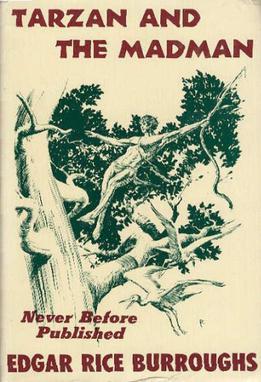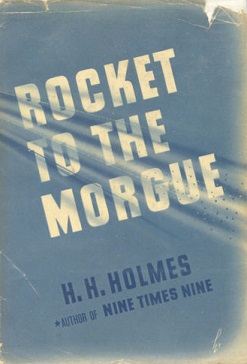Related Research Articles

Edgar Rice Burroughs was an American writer, best known for his prolific output in the adventure, science fiction, and fantasy genres. Best known for creating the characters Tarzan and John Carter, he also wrote the Pellucidar series, the Amtor series, and the Caspak trilogy.
This article contains information about the literary events and publications of 1917.
This article contains information about the literary events and publications of 1920.
This article contains information about the literary events and publications of 1931.

Scientific romance is an archaic, mainly British term for the genre of fiction now commonly known as science fiction. The term originated in the 1850s to describe both fiction and elements of scientific writing, but it has since come to refer to the science fiction of the late nineteenth and early twentieth centuries, primarily that of Jules Verne, H. G. Wells and Arthur Conan Doyle. In recent years the term has come to be applied to science fiction written in a deliberately anachronistic style as a homage to or pastiche of the original scientific romances.
Arthur Porges was an American writer of numerous short stories, most notably during the 1950s and 1960s, though he continued to write and publish stories until his death.

Zenna Chlarson Henderson was an American elementary school teacher and science fiction and fantasy author. Her first story was published in The Magazine of Fantasy & Science Fiction in 1951. Her work is cited as pre-feminist, often featuring middle-aged women, children, and their relationships, but with stereotyped gender roles. Many of her stories center around human aliens called "The People", who have special powers. Henderson was nominated for a Hugo Award in 1959 for her novelette Captivity. Science fiction authors Lois McMaster Bujold, Orson Scott Card, Connie Willis, Dale Bailey, and Kathy Tyers have cited her as an influence on their work.

A Princess of Mars is a science fantasy novel by American writer Edgar Rice Burroughs, the first of his Barsoom series. It was first serialized in the pulp magazine All-Story Magazine from February–July, 1912. Full of swordplay and daring feats, the novel is considered a classic example of 20th-century pulp fiction. It is also a seminal instance of the planetary romance, a subgenre of science fantasy that became highly popular in the decades following its publication. Its early chapters also contain elements of the Western. The story is set on Mars, imagined as a dying planet with a harsh desert environment. This vision of Mars was based on the work of the astronomer Percival Lowell, whose ideas were widely popularized in the late 19th and early 20th centuries.

Richard Allen Lupoff was an American science-fiction and mystery author, who also wrote humor, satire, nonfiction and reviews. In addition to his two dozen novels and more than 40 short stories, he also edited science-fantasy anthologies. He was an expert on the writing of Edgar Rice Burroughs, and had an equally strong interest in H. P. Lovecraft. He also co-edited the non-fiction anthology All in Color For a Dime, which has been described as "the very first published volume dedicated to comic book criticism"; as well as its sequel, The Comic-Book Book.
The lost world is a subgenre of the fantasy or science fiction genres that involves the discovery of an unknown Earth civilization. It began as a subgenre of the late-Victorian adventure romance and remains popular into the 21st century.

Adventure fiction is a type of fiction that usually presents danger, or gives the reader a sense of excitement. Some adventure fiction also satisfies the literary definition of romance fiction.

Farewell, Fantastic Venus is a 1968 American science fiction anthology edited by Brian Aldiss and Harry Harrison. An abridged version was published in the same year under the title All About Venus. It was first published as a direct response to the information returned from the first space probes sent to Venus, especially the first atmospheric probe to return data, Venera 4. The first data was not returned from the surface until Venera 7 successfully landed in 1970.

NESFA Press is the publishing arm of the New England Science Fiction Association, Inc. The NESFA Press primarily produces three types of books:

"Facts Concerning the Late Arthur Jermyn and His Family" is a short story in the horror fiction genre, written by American author H. P. Lovecraft in 1920. The themes of the story are tainted ancestry, knowledge that it would be best to remain unaware of, and a reality which human understanding finds intolerable.

Tarzan and the Madman is a novel by American writer Edgar Rice Burroughs, the twenty-third in his series of twenty-four books about the title character Tarzan. Written from January to February 1940, the story was never published in Burroughs' lifetime. The book was first published in hardcover by Canaveral Press in June 1964, and in paperback by Ballantine Books in February 1965.

Chris "C. J." Henderson was an American writer of horror, hardboiled crime fiction and comic books, known for such works as the Piers Knight and Teddy London series. His comics work includes books for Marvel Comics and Valiant Comics.

Rocket to the Morgue is a 1942 American locked room mystery novel by Anthony Boucher.
The year 1912 was marked, in science fiction, by the following events.
The year 1928 was marked, in science fiction, by the following events.
The year 1930 was marked, in science fiction, by the following events.
References
- ↑ "Obituary: Anthony Burgess" . The Independent. Archived from the original on 2022-05-01. Retrieved 18 June 2018.
- ↑ III, Harris M. Lentz (2008). Obituaries in the Performing Arts, 2007: Film, Television, Radio, Theatre, Dance, Music, Cartoons and Pop Culture. McFarland. p. 123. ISBN 9780786434817.
- ↑ "Robert Albert Bloch - American writer". Encyclopedia Britannica. Retrieved 18 June 2018.
- ↑ "Jack Kirby - Biography, Characters, & Influence". Encyclopedia Britannica. Retrieved 18 June 2018.
- ↑ "Authors : Henderson, Zenna : SFE : Science Fiction Encyclopedia". www.sf-encyclopedia.com. Retrieved 31 March 2019.
- ↑ Roberts, Adam (9 December 2017). "Arthur C Clarke at 100: still the king of science fiction". the Guardian. Retrieved 18 June 2018.
- ↑ "Edgar Rice Burroughs - American novelist". Encyclopedia Britannica. Retrieved 18 June 2018.